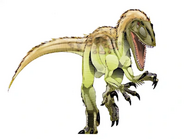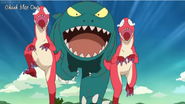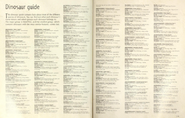| Achillobator | ||||
|---|---|---|---|---|

| ||||
| Name | Achillobator | |||
| Class | Dromaeosauridae | |||
| Name Translation | Named after Achilles | |||
| Period | Late Cretaceous | |||
| Location | Mongolia | |||
| Diet | Meat | |||
| Size | 16-20 ft (5-6 m) | |||
Achillobator's history is not well known. The only skeleton known is being debated whether or not it is two dinosaurs.
Achillobator ( /əˌkɪlɵˈbeɪtɔr/; "Achilles' warrior/hero") is a genus of large dromaeosaurid theropod dinosaur from the late Cretaceous Period of what is now Mongolia, about 90 million years ago. It was probably an active bipedal predator, hunting with the large sickle-shaped claw on the second toe of each hind foot. It was a large dromaeosaurid: the holotype and only known individual of Achillobator is estimated at 6 metres (20 ft) long, around the same length as the closely related Utahraptor.
The generic name comes from Achilles, a famous ancient Greek warrior of the Trojan War, and the Mongolian word bator ("warrior" or "hero"). It refers to the large Achilles tendon needed to use the sickle claw on the foot, which was the major combat organ of dromaeosaurids. The one species is named A. giganticus because it is much larger than most other dromaeosaurids.
The fossil remains of Achillobator were first discovered during a Mongolian and Russian field expedition in 1989, though it was not described and named until ten years later, in 1999,by Mongolian paleontologist Altangerel Perle, and Americans Mark Norell and Jim Clark, although the description was not complete and was actually published without the knowledge of the latter two authors.
Fossil bones of Achillobator were found mostly disarticulated, but associated, including a fragment of the upper jaw with teeth, as well as vertebrae from all sections of the spinal column, ribs, and bones from the shoulder, pelvis, forelimbs and hindlimbs. These remains were found in the Bayan Shireh Formation of Dornogovi Province, Mongolia, which dates to the Late Cretaceous epoch. The exact age is uncertain, with two competing hypotheses; based on comparisons with other formations, the Bayan Shireh fauna seems to correspond best with the Turonian through early Campanian stages of the Late Cretaceous, about 93 to 80 million years ago. However, examination of the magnetostratigraphy of the formation seems to confirm that the entire Bayan Shireh lies within the Cretaceous Long Normal, which lasted only until the end of the Santonian stage, giving a possible Cenomanian through Santonian age, or between 90 and 83 million years ago.Other dinosaurs found in the Bayan Shireh include Alectrosaurus, Segnosaurus, Talarurus, and Bactrosaurus.








